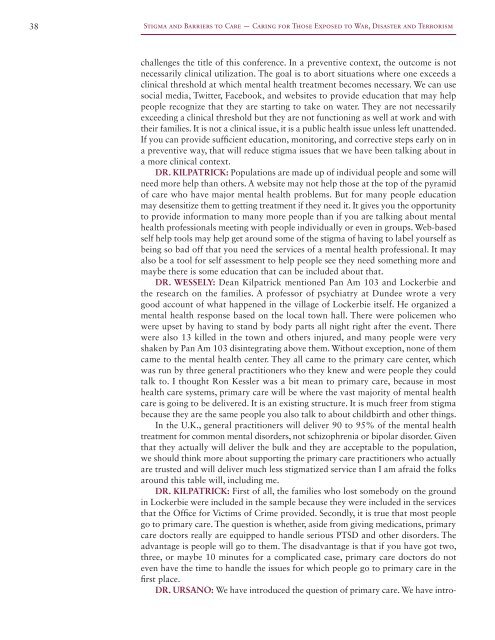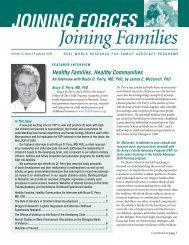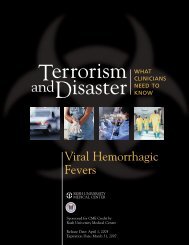stigma and barriers to care - Uniformed Services University of the ...
stigma and barriers to care - Uniformed Services University of the ...
stigma and barriers to care - Uniformed Services University of the ...
Create successful ePaper yourself
Turn your PDF publications into a flip-book with our unique Google optimized e-Paper software.
38<br />
Stigma <strong>and</strong> Barriers <strong>to</strong> Care — Caring for Those Exposed <strong>to</strong> War, Disaster <strong>and</strong> Terrorism<br />
challenges <strong>the</strong> title <strong>of</strong> this conference. In a preventive context, <strong>the</strong> outcome is not<br />
necessarily clinical utilization. The goal is <strong>to</strong> abort situations where one exceeds a<br />
clinical threshold at which mental health treatment becomes necessary. We can use<br />
social media, Twitter, Facebook, <strong>and</strong> websites <strong>to</strong> provide education that may help<br />
people recognize that <strong>the</strong>y are starting <strong>to</strong> take on water. They are not necessarily<br />
exceeding a clinical threshold but <strong>the</strong>y are not functioning as well at work <strong>and</strong> with<br />
<strong>the</strong>ir families. It is not a clinical issue, it is a public health issue unless left unattended.<br />
If you can provide sufficient education, moni<strong>to</strong>ring, <strong>and</strong> corrective steps early on in<br />
a preventive way, that will reduce <strong>stigma</strong> issues that we have been talking about in<br />
a more clinical context.<br />
DR. KILPATRICK: Populations are made up <strong>of</strong> individual people <strong>and</strong> some will<br />
need more help than o<strong>the</strong>rs. A website may not help those at <strong>the</strong> <strong>to</strong>p <strong>of</strong> <strong>the</strong> pyramid<br />
<strong>of</strong> <strong>care</strong> who have major mental health problems. But for many people education<br />
may desensitize <strong>the</strong>m <strong>to</strong> getting treatment if <strong>the</strong>y need it. It gives you <strong>the</strong> opportunity<br />
<strong>to</strong> provide information <strong>to</strong> many more people than if you are talking about mental<br />
health pr<strong>of</strong>essionals meeting with people individually or even in groups. Web-based<br />
self help <strong>to</strong>ols may help get around some <strong>of</strong> <strong>the</strong> <strong>stigma</strong> <strong>of</strong> having <strong>to</strong> label yourself as<br />
being so bad <strong>of</strong>f that you need <strong>the</strong> services <strong>of</strong> a mental health pr<strong>of</strong>essional. It may<br />
also be a <strong>to</strong>ol for self assessment <strong>to</strong> help people see <strong>the</strong>y need something more <strong>and</strong><br />
maybe <strong>the</strong>re is some education that can be included about that.<br />
DR. WESSELY: Dean Kilpatrick mentioned Pan Am 103 <strong>and</strong> Lockerbie <strong>and</strong><br />
<strong>the</strong> research on <strong>the</strong> families. A pr<strong>of</strong>essor <strong>of</strong> psychiatry at Dundee wrote a very<br />
good account <strong>of</strong> what happened in <strong>the</strong> village <strong>of</strong> Lockerbie itself. He organized a<br />
mental health response based on <strong>the</strong> local <strong>to</strong>wn hall. There were policemen who<br />
were upset by having <strong>to</strong> st<strong>and</strong> by body parts all night right after <strong>the</strong> event. There<br />
were also 13 killed in <strong>the</strong> <strong>to</strong>wn <strong>and</strong> o<strong>the</strong>rs injured, <strong>and</strong> many people were very<br />
shaken by Pan Am 103 disintegrating above <strong>the</strong>m. Without exception, none <strong>of</strong> <strong>the</strong>m<br />
came <strong>to</strong> <strong>the</strong> mental health center. They all came <strong>to</strong> <strong>the</strong> primary <strong>care</strong> center, which<br />
was run by three general practitioners who <strong>the</strong>y knew <strong>and</strong> were people <strong>the</strong>y could<br />
talk <strong>to</strong>. I thought Ron Kessler was a bit mean <strong>to</strong> primary <strong>care</strong>, because in most<br />
health <strong>care</strong> systems, primary <strong>care</strong> will be where <strong>the</strong> vast majority <strong>of</strong> mental health<br />
<strong>care</strong> is going <strong>to</strong> be delivered. It is an existing structure. It is much freer from <strong>stigma</strong><br />
because <strong>the</strong>y are <strong>the</strong> same people you also talk <strong>to</strong> about childbirth <strong>and</strong> o<strong>the</strong>r things.<br />
In <strong>the</strong> U.K., general practitioners will deliver 90 <strong>to</strong> 95% <strong>of</strong> <strong>the</strong> mental health<br />
treatment for common mental disorders, not schizophrenia or bipolar disorder. Given<br />
that <strong>the</strong>y actually will deliver <strong>the</strong> bulk <strong>and</strong> <strong>the</strong>y are acceptable <strong>to</strong> <strong>the</strong> population,<br />
we should think more about supporting <strong>the</strong> primary <strong>care</strong> practitioners who actually<br />
are trusted <strong>and</strong> will deliver much less <strong>stigma</strong>tized service than I am afraid <strong>the</strong> folks<br />
around this table will, including me.<br />
DR. KILPATRICK: First <strong>of</strong> all, <strong>the</strong> families who lost somebody on <strong>the</strong> ground<br />
in Lockerbie were included in <strong>the</strong> sample because <strong>the</strong>y were included in <strong>the</strong> services<br />
that <strong>the</strong> Office for Victims <strong>of</strong> Crime provided. Secondly, it is true that most people<br />
go <strong>to</strong> primary <strong>care</strong>. The question is whe<strong>the</strong>r, aside from giving medications, primary<br />
<strong>care</strong> doc<strong>to</strong>rs really are equipped <strong>to</strong> h<strong>and</strong>le serious PTSD <strong>and</strong> o<strong>the</strong>r disorders. The<br />
advantage is people will go <strong>to</strong> <strong>the</strong>m. The disadvantage is that if you have got two,<br />
three, or maybe 10 minutes for a complicated case, primary <strong>care</strong> doc<strong>to</strong>rs do not<br />
even have <strong>the</strong> time <strong>to</strong> h<strong>and</strong>le <strong>the</strong> issues for which people go <strong>to</strong> primary <strong>care</strong> in <strong>the</strong><br />
first place.<br />
DR. URSANO: We have introduced <strong>the</strong> question <strong>of</strong> primary <strong>care</strong>. We have intro-




